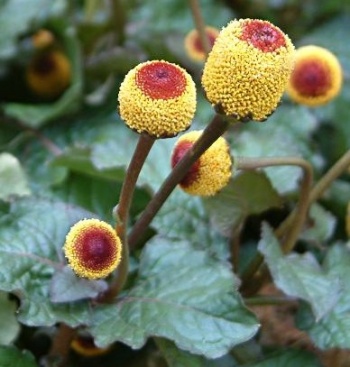Difference between revisions of "Acmella Oleracea"
(→Recommended Products) |
(→Recommended Products) |
||
| Line 10: | Line 10: | ||
* used to treat sore throats and parasitic blood infections. It has anti-inflammatory properties that relieve the discomfort of rheumatism. Chewing the flowers and leaves promotes the production of saliva and is a natural treatment for dry mouth. The root is commonly used in the Philippines to relieve constipation. | * used to treat sore throats and parasitic blood infections. It has anti-inflammatory properties that relieve the discomfort of rheumatism. Chewing the flowers and leaves promotes the production of saliva and is a natural treatment for dry mouth. The root is commonly used in the Philippines to relieve constipation. | ||
* has been used as a traditional treatment for stammering. It is also a powerful diuretic and can help lower blood pressure. Extracts, infusions, and powders made from the leaves and flowers are the most common methods of using Acmella oleracea. It has traditionally most often been ingested as a tea. | * has been used as a traditional treatment for stammering. It is also a powerful diuretic and can help lower blood pressure. Extracts, infusions, and powders made from the leaves and flowers are the most common methods of using Acmella oleracea. It has traditionally most often been ingested as a tea. | ||
| − | + | ||
| − | + | ||
| − | + | ||
| − | + | ||
| − | + | ||
| − | + | ||
| − | + | ||
[[Category:Treatments]] | [[Category:Treatments]] | ||
[[Category:herbal medicine]] | [[Category:herbal medicine]] | ||
Revision as of 10:22, 6 October 2014
Other names : Toothache Plant, Eyeball Plant, Peek-A-Boo Plant, Spot Plant, Prickelblume, Alphabet Plant, Jambu, Australian Cress, and Brazil Cress, Para cress, Akarkar, Pipulka, Akarkara, Hemmugalu, Pirazha, Acmella oleracea, Spilanthes acmella var. oleracea, Spilanthes fusca
It is an annual that grows to a height of 12 to 15 inches (30 to 38 centimeters) with a spread of 24 to 30 inches (61 to 76 centimeters). This member of the daisy family is a tender, fast-growing ornamental, culinary and medicinal plant native to Brazil. It is commonly known by the names toothache plant and paracress. The herb takes the latter name from Para, the Brazilian state where Acmella oleracea is used extensively for both culinary and medicinal uses. In its native habitat in the tropics of Brazil, the toothache plant is a perennial, but in cooler climates where it is too tender to survive the winters, it can be treated as an annual.
Special Precautions of Acmella Oleracea
The leaves and flower heads contain analgesic, antifungal, anthelminthic, and antibacterial agents, but some of the compounds are destroyed by desiccation or freezing.
The benefits of Acmella Oleracea are
When used as a natural medicine, Acmella oleracea is employed principally to treat toothaches and gum disease. It has also been used as a remedy for malaria, elephantiasis, arthritis, and dysentery. Acmella oleracea has antibiotic, antifungal, anti-inflammatory, and antiseptic properties.
- Spilanthes extract has been discovered to aid in saliva stimulation for people suffering from dry mouth. A decoction or infusion of the leaves and flowers is a traditional remedy for stammering, toothache, stomatitis, and throat complaints. The flowers don’t have any petals, and appear at the top of stalks that rise above the leaves. The dried or fresh flower heads and leaves can be used medicinally or as condiments, and the leaves are treated as a leafy green vegetable. They can also be used as a topical analgesic in the mouth. When the raw leaves or flowers are chewed, the mouth and gums become numb from the analgesic constituent spilanthol, providing temporary relief from the pain of toothaches and mouth sores.
- Used topically to provide a natural facelift. When the extract is applied to the face, it relaxes muscles just under the surface of the skin, reducing facial wrinkles and lines caused by tension. Application of Acmella extract is reported to result in more relaxed facial muscle, and in turn, decreases visible wrinkles and age lines. Some people compare it to BOTOX®, but without the toxic effects and without the need to inject it under the skin; making it a cheap and easy BOTOX® replacement.
- Can also be applied to wounds to speed healing. Its antifungal properties make it an effective treatment for candidiasis and ringworm.
- used to treat sore throats and parasitic blood infections. It has anti-inflammatory properties that relieve the discomfort of rheumatism. Chewing the flowers and leaves promotes the production of saliva and is a natural treatment for dry mouth. The root is commonly used in the Philippines to relieve constipation.
- has been used as a traditional treatment for stammering. It is also a powerful diuretic and can help lower blood pressure. Extracts, infusions, and powders made from the leaves and flowers are the most common methods of using Acmella oleracea. It has traditionally most often been ingested as a tea.
